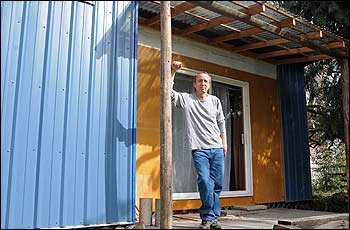Nesting Green Home & Garden Special Issue
Permaculturing South Lane Fern Hill Nursery offers large collection
How Do I Get Myself Some Birds? Birders, in their own backyards
Downsize to a Greener Lifestyle Kurt Jensen’s little houses for better living
Seed, Save, Share A revolutionary act against commercial seed industry
Green and Cheap BRING offers remodel options that go easy on the budget
Downsize to a Greener Lifestyle
Kurt Jensen’s little houses for better living
By Rachel Coussens
Want to live green? Go small.
Or so says Kurt Jensen, owner of Cascase Small House Company, which provides green homes to the community that are 1,000 square feet or less. “It’s really a step in the right direction toward affordable housing,” Jensen says. “I think that everyone wants a home of their own, and this makes it easier.”
 |
Jensen (who has been a staff photographer for the Weekly) lives in a small house. His house is 300 square feet with 80 percent recycled products, including cedar planks. His kitchen doubles as an office, and his bedroom doubles as a living room. He uses curtains to separate rooms. Besides living in a small home, Jensen has about 25 years experience with building houses. “I’ve build single-family homes, apartment buildings, yurts, big houses and little houses,” he says.
“What is really nice about small houses is your material cost are much lower and your energy costs are much lower,” Jensen says. In addition to his house being a smaller space to cool and heat, passive solar energy and heavy insulation allow energy costs to stay low. “What we really want to shoot for is really low energy and, if people want to invest in photovoltaics, we can shoot for zero energy — a home that produces all of the energy that it uses,” Jensen says.
His houses sell for about $10 a square foot and up depending on material costs. “We try to use sustainable materials throughout,” he says, “though of course that is up to the homeowner.” Jensen says that sustainable wood can cost up to three times as much as using regular wood.
Foundations made of clay and wood fibers provide customers with greener options. Ground up newspaper or cotton fiber materials can be used in insulation creating a higher usage of recycled products. The house can be furnished with reused goods as well.
Jensen tries to get all of the building materials locally in Eugene and Oregon. He finds a lot of items at BRING Recycling in Eugene, but he says that some items cannot be found locally. For example, some customers may prefer sustainably harvested wood that he buys from Warm Springs Forest Products Industries in central Oregon.
It takes two to three months to build a small house. Jensen builds as much of the house as he can offsite in a garage to keep the it out of the elements, and then, he says, it takes about a week to set up the house on-site. The time it takes to create a house depends on what materials customers wish to use. “Since it is so cutting edge, the material is not as available as commonly used stuff,” he says.
When someone approaches Jensen about creating a house for them, he first looks at the lot to see how passive solar design can be used in the design. He then works with the client to ensure all of their design needs are met. Jensen’s company outsources work for the architecture, foundation, electrical and plumbing work.
“When a lot of people think of downsizing, they think they are sacrificing stuff, and really they are not,” Jensen says. The houses are built to the same safety codes as larger houses, he says, making them just as safe as the larger houses. Jensen believes that small houses are safe, comfortable, healthy and visually appealing.
“People who live in small houses don’t feel confined; they feel liberated. I see it as the way we’re headed — the future of home building,” he says.